The Association for Mormon Letters Awards were presented at Utah Valley University, April 22, 2017. In addition to the awards below, Orson Scott Card was presented with the Smith-Pettit Foundation Award for Outstanding Contribution to Mormon Letters, and Susan Elizabeth Howe was presented with the Association for Mormon Letters Lifetime Achievement Award.
Comics
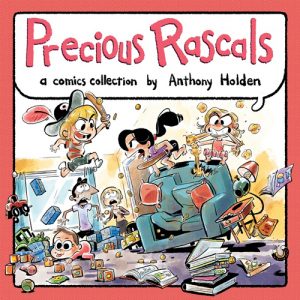 Anthony Holden. Precious Rascals
Anthony Holden. Precious Rascals
Precious Rascals by Anthony Holden is a delightful book. Featuring short journal comics about Holden’s life from his time as a newlywed to his firstborn son and each increasingly rambunctious child, the antics in “Precious Rascals” should be familiar to every parent. Church is a small but consistent facet of the Holden household, including rousing renditions of “Book of Mormon Stories.” Holden combines charming artwork spanning a decade, advice about life and cartooning, bonus animations, and, of course, bathroom humor. His comics are a reminder that parenthood, much like childhood, should be full of laughter and play (and waffles).
Other finalists:
Scott Hales. Mormon Shorts, Vol. 1.
Brandon Sanderson (story), Rik Hoskin (script), Julius Gopez (art), and Ross Campbell (colors). White Sand.
Creative Non-Fiction
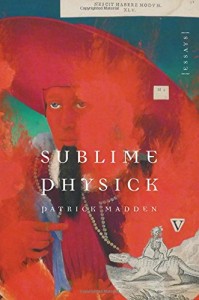 Patrick Madden. Sublime Physick. University of Nebraska Press.
Patrick Madden. Sublime Physick. University of Nebraska Press.
Mormonism is in many ways dominated by scriptural stories, narratives comprised of, more often than not, personal essays and memoirs, but which become, by virtue of their central importance to the religion, essentialized and canonized. Nephi isn’t often read as he is, an aging man reinterpreting his youthful experiences decades after the fact; he is read as an everyperson, his experiences a template and a touchstone for our own, his version of events the “true” reading of history. In judging this contest of “Mormon letters” and creative nonfiction, therefore, we found ourselves drawn to the pedestrian rather than the political, the mundane rather than the massive, to specific people responding to specific situations where faith figures into the narrative but the choices need not be pointed to as right or wrong or examples of virtuous living or its opposite. While all the finalists provided such stories, the winner and honorable mention did so in ways that made them stick with us, invading our thoughts and conversations for weeks after reading.
Of all the entries Patrick Madden’s Sublime Physick offers the most expansive view of the universe (a feature Mormons like to claim for their religion), but does so in a way that is wholly personal and that resists any attempt of being seen as quintessentially “Mormon.” Madden’s style does not initially dazzle but in time reveals its deceptively careful crafting, and his essays must first teach new readers not to jump to conclusions about meanings or morals before offering their subtler rewards—but this is part of its strength and appeal. Religion is neither the focus nor the impetus of the writing; rather, it is merely one of several filters through which the author’s experiences and thoughts pass on their way to the page. The witty observations and deep dives that are the result represent how one man—a man who happens to be Mormon but who is also obsessed with pop culture, physics, and his essaying forebears—interacts with his life, and in so doing they encourage the rest of us to more consciously interact with our own. The effect is that the reader is invited into a sort of one-man, parallel Mormon thought and culture, one with a completely new set of preoccupations and that welcomes the reader’s own.
Creative Non-fiction, Honorable Mention
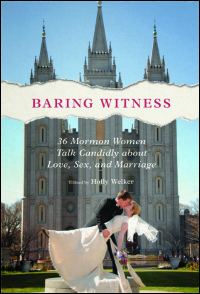 Holly Welker, editor. Baring Witness: 36 Mormon Women Talk Candidly about Love, Sex and Marriage. University of Illinois Press.
Holly Welker, editor. Baring Witness: 36 Mormon Women Talk Candidly about Love, Sex and Marriage. University of Illinois Press.
While Madden’s Mormonism is largely a subtext, the authors of the essays in Holly Welker’s Baring Witness approach it with urgency, making the Latter-day Saint faith and its culture central to their examinations of marriage. The three dozen stories individually run the gamut—some of the essays are lyrical and beautifully wrought, others are simple and unrefined; some discuss the preservation of a marriage, others its dissolution, others still its absence; and the writers take up every possible stance in relation to their faiths. Encountered alone, any one essay may or may not succeed, but collected and presented together, they shirk any pretense of prescriptivism. Reading this collection of intimate, intelligent, and terribly interesting essays is an exercise in empathy that truly ought to be considered required reading to the 21st century Latter-day Saint seeking to truly mourn with those that mourn, and comfort those that stand in need of comfort. Baring Witness broadcasts voices of Mormon women that are all too often quietly dismissed in the broader aspects of our culture. In the end, these stories consist of sacred narratives—not so much a record of God’s dealing with people but of people’s dealing with God.
Other finalists:
Scott Abbott. Immortal for Quite Some Time. University of Utah Press.
Judith Freeman. The Latter Days: A Memoir. Pantheon.
Ashley Mae Hoiland. One Hundred Birds Taught me to Fly. Neal A. Maxwell Institute for Religious Scholarship.
Criticism
 Jack Harrell. Writing Ourselves: Essays on Creativity, Craft, and Mormonism. Greg Kofford Books.
Jack Harrell. Writing Ourselves: Essays on Creativity, Craft, and Mormonism. Greg Kofford Books.
The Association of Mormon Letters is pleased to present the award for Criticism to Jack Harrell for his collection of essays on literary theory, creative writing strategies, Mormon literary history, and his advice to would-be Mormon writers and critics, Writing Ourselves: Essays on Creativity, Craft, and Mormonism, published by Greg Kofford Books. The best of the essays, “Toward a Mormon Literary Thought,” is a worthy successor to the work of Eugene England, one of the author’s heroes. And rightly so. At his most engaging, Harrell speaks bluntly, knowingly, and aspirationally regarding the plight of the serious Mormon writer, and by extension, their audience. His advice to writers to be honest and to embrace their weirdness, among other things, seeks to reframe the discussion of Mormonism’s cultural debits and credits into a workable and motivational mode of authentic creativity.
Drama
 Morag Shepherd. Burn. Sackerson Theater Company, Salt Lake City. September-October.
Morag Shepherd. Burn. Sackerson Theater Company, Salt Lake City. September-October.
One of many lines from Morag Shepherd’s play, Burn, that announces itself could very well be considered the theme of this play: “This isn’t about God. It’s about life.”
And what a life. It’s a play about sex, religion, cutting, self-immolation, murder, nature-worship and the importance of family and what can happen when a family is dysfunctional. It’s about love, hate, sisters, mothers, and fathers. It’s about life indeed. God is mentioned but then God is part of life.
Burn is a mélange of memories, replayed and then remembered a second time but differently, like real memories. Which memory is the true story of past events? Or are they both wrong. As real memories are.
It challenges its audience. Like it or not, if you jump into Burn and stay there until the end (the word “climax” doesn’t seem to fit), you will find yourself being yanked first this way then that way, all the while asking yourself: “Am I in a dream? A nightmare? Remembered truths or false memories?” It’s hard to tell and I think that’s the beauty of this play. It should be this way.
Burn reinvents minimalism. At first perusal, it seems almost free-form, but upon a closer reading, the lines connect, each building on the last. There isn’t a useless word in the whole thing. The dialogue is sparse, cutting to the core, its meaning lying between the lines more than what is actually said. Subtext abounds, fascinating, with several poignant lines like the one quoted above. The only mentioned set piece is a tree, whose leaves become essential props that give us a glimpse into what is really happening (and even then, we are not sure.)
Burn is a dream where reality is always just beyond reach. It is poetry, absurdist theatre, theatre of cruelty, naturalistic, and realistic, blending several genres into one, a salmagundi of styles.
Burn is an incredible and profound work of theatrical imagination, a dream/nightmare/memory/free association ball of amazement and delight which not only deserves the AML award for drama but many future productions.
Other finalists:
Matthew Greene. Gregorian
Jenifer Nii. Kingdom of Heaven
Javen Tanner. The King’s Men
Film
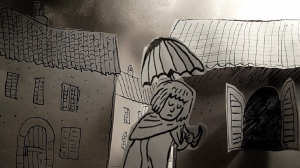 The Split House. Annie Poon, director and writer.
The Split House. Annie Poon, director and writer.
Despite the multiple meanings of its title, The Split House showcases artist Annie Poon’s impressive ability to combine and merge multiple profound concerns, including mental illness, Mormon missionary life, emotional distress and spiritual healing. The title contains multiple autobiographical meanings: The story begins in Split, Croatia, where Poon was a Mormon missionary, and it also deals with the split nature of a mind affected by schizoaffective disorder. But Poon’s authenticity in expressing several painful aspects of life make the work a significant achievement in Mormon film. Throughout the film (as well as her other visual art), Poon’s vibrant faith comes across as both entirely Mormon and entirely her own. The Split House portrays Mormon theology and scripture without amendment while preserving a potent sense of spiritual adventurousness. The aesthetic high points of the film include a rich soundscape of original music and sound effects and imaginative visuals throughout. Though short in length, the film stays with you, and it rewards multiple viewings to notice new moments of beauty and pleasure.
Other finalists:
Masterminds. Jared Hess, director.
The Next Door. Barrett Burgin, director,
Raiders! The Story of the Greatest Fan Film Ever Made. Jeremy Coon and Tim Skousen, directors.
Saturday’s Warrior. Michael Buster, director.
Middle Grade Novel
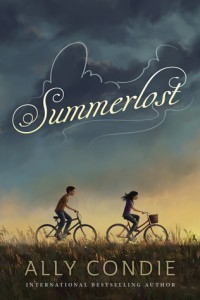 Ally Condie. Summerlost. Dutton
Ally Condie. Summerlost. Dutton
With an understated almost serene prose, Ally Condie’s Summerlost
Dave Butler. The Kidnap Plot: The Incredible Adventures of Clockwork Charlie. Knopf
Tess Hilmo. Cinnamon Moon. Farrar, Straus and Giroux
Liesl Shurtliff. Red: The True Story of Red Riding Hood. Knopf
Novel
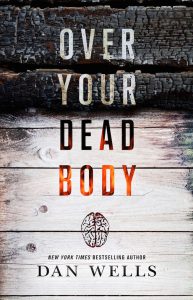 Dan Wells. Over Your Dead Body. Tor. John Cleaver series #5
Dan Wells. Over Your Dead Body. Tor. John Cleaver series #5
With a main character that cuts into your heart and rips at your emotions, Over Your Dead Body eats at you with big questions of conscience, metaphors that slash deep into the psychology of humanity, and writing that balances art and story and pace and emotion in a way that leaves the pages turning on their own. Over Your Dead Body is a story that bleeds through the boundaries of genre and becomes something bigger than just monsters, but overcoming what we all fear lies deep within each of us. Through all the grittiness and horror, Wells triumphs with a literariness and subtlety not always managed in such a genre. He weaves together plot and theme, and gently leaves readers with the idea that sometimes even demons can elicit pity, and sometimes our worst parts can be our greatest strengths. Wells’ writing is delicately tuned and subtle, and yet still big enough for this story. He writes a sweeping cross-genre of psychological thriller and dark fantasy. Wells’ writing has been on the bestseller lists multiple times, and it deserves to be there. He is a credit to the LDS writing community.
H. B. Moore. Slave Queen, Thomas & Mercer/Amazon. Omar Zagouri Thriller Series #3.
Julie J. Nichols. Pigs When they Straddle the Air. Zarahemla Books.
Shawn Vestal. Daredevils. Penguin.
Picture Book
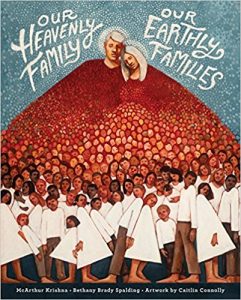 Our Heavenly Family, Our Earthly Families. by McArthur Krishna and Bethany Brady Spalding. Illustrated by Caitlin Connolly. Deseret Book
Our Heavenly Family, Our Earthly Families. by McArthur Krishna and Bethany Brady Spalding. Illustrated by Caitlin Connolly. Deseret Book
In some ways, Our Heavenly Families is more workbook than narrative, organized around fifteen key ideas exploring the Mormon doctrine on family. The writing is masterful in allowing room for readers to reconcile the true complexity of lived family life with doctrine, quotes from LDS leaders, and even The Family Proclamation. The authors ask evocative questions, prodding readers to connect more deeply with the concepts at hand while leaving many conclusions open ended for personalization. The structure and content of the writing, however satisfying, comes second to the remarkable illustrations by Caitlin Connolly. Not only does her visual work reinforce the themes at hand, Connolly has produced a book full of iconic religious art, deeply symbolic and spiritual. Her visual work is so complete and intelligent it competes with the text for impact, a truly unique contribution to our Mormon cultural landscape.
Other finalists:
What Would It Be Like? By McArthur Krishna. Illustrated by Ayeshe Sadr & Ishaan Dasgupta. Amberjack Publishing.
She Stood for Freedom: The Untold Story of a Civil Rights Hero, Joan Trumpauer Mulholland. By Loki Mulholland and Angela Fairwell. Illustrated by Charlotte Janssen. Shadow Mountain.
Defenders of the Family. By Benjamin Hyrum White. Illustrated by Jay Fontano. Cedar Fort, Inc.
Poetry
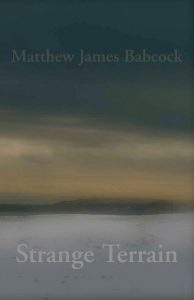 Matthew James Babcock. Strange Terrain. MadHat Press.
Matthew James Babcock. Strange Terrain. MadHat Press.
Matthew James Babcock’s Strange Terrain invites readers into the varied and, indeed, strange landscapes of the world, the self, and their intersecting locales. The poet sets the globe spinning like a prayer wheel, a whirling map covered in push pins—marking this running trail, that cobblestone walk—and takes readers along on a dizzying ride.
Babcock’s poems contain shadow and light, a mixture of humor and gravitas, dwelling on such topics as the nature of the soul, how it “is a little girl always / breaking from her father’s grip,” or the trick of ensuring ordinary “Miniature Golf Karma,” the kind that changes five bucks donated into a McDowell’s Girls Basketball win.
Babcock is a poet of skillful experimentation, almost restless in trying out an assortment of forms: Sapphics, sestinas, couplets, paradelles, and more. The collection opens with a series of Idaho Études and ends with a sonnet corona. Babcock infuses these poems with generous music and lightly-leaping associative imagery. He manages to infuse these forms with vibrant energy.
Readers will feel they are in the hands of a logophile who treats language as raw material, the way a composer approaches notes, instruments, acoustic space, or a painter her canvas, oils, brushes. These poems have a forward momentum that sweeps readers along through their vivacity, their tethered nowness captured in vivid specificity of naming, of word choice that insists on the banal in the sacred uniqueness of all that goes into the making of our complex world.
Other finalists:
Neil Aitken. Leviathan. Hyacinth Girl Press.
Lisa Bickmore. flicker. Elixir Books.
Alex Caldiero, Who is the Dancer, What is the Dance. Salt Front Press.
Jeffrey Tucker. Kill February. Sage Hill Press.
Religious Non-fiction
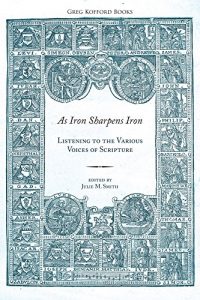 Julie M. Smith, editor. As Iron Sharpens Iron: Listening to the Various Voices of Scripture. Greg Kofford Books. Contributors: Julie M Smith, Michael Austin, Mark T. Decker, Nicholas J. Frederick, Heather Hardy, Ronan James Head, James D. Holt, Jason A. Kerr, Jared Ludlow, Steven L. Peck, Joseph M. Spencer, Walter E. A. van Beek, Miranda Wilcox, Walker Wright, Benjamin Peters, and John Durham Peters.
Julie M. Smith, editor. As Iron Sharpens Iron: Listening to the Various Voices of Scripture. Greg Kofford Books. Contributors: Julie M Smith, Michael Austin, Mark T. Decker, Nicholas J. Frederick, Heather Hardy, Ronan James Head, James D. Holt, Jason A. Kerr, Jared Ludlow, Steven L. Peck, Joseph M. Spencer, Walter E. A. van Beek, Miranda Wilcox, Walker Wright, Benjamin Peters, and John Durham Peters.
The Association for Mormon Letters stated purpose is to promote “quality writing by, for, and about Mormons.” In pursuit of this goal, the Association rewards the best of Mormon literary efforts in various genre to recognize and promote new works and greater understanding of our shared culture. The Association for Mormon Letters Religious Non-fiction Award is given annually to an author or editor who has produced a book that is both an artistic, finely written piece of literature which also sheds new light and insight on Mormon thought, theology, and practice. The competition for the 2017 Religious Non-Fiction Award was very fierce. All of the finalists are masters of their craft. All of their books shed new light on and broke new ground in Mormon Studies. Many of them have won awards for their writing before and they will likely win more in the future.
It is with great pleasure that we give this years Religious Non Fiction Award to Julie M Smith who was the editor of the Greg Kofford published volume “As Iron Sharpens Iron: Listening to the Various Voices of Scripture”. “As Iron Sharpens Iron” provides an excellent study on the challenges found in the Mormon scriptural cannon in a manner that is very intriguing and is sure to challenge Mormon readers to rethink how they approach their scriptural studies and thought. Mormons try harder than most Christians to try and find complete harmony in the scriptural cannon, but as Smith observes, the scriptures are filled with “weird bits”, “profound disagreement(s)” and “not all scripture texts agree with each other…since no writer has been freed from the confines of his (or her) fallen state”. The authors in “As Iron Sharpens Iron” were allowed to choose various scriptural authors and figures with disagreeing positions and rather than force them to harmonize these authors allowed their subjects to have a “dialogue” and debate with each other in an attempt to air out their differences and work through their opposing positions in a search for more truth, even when that meant continuing to disagree with each other at the end of the “conversation”. The result is a book that is sure to intrigue, challenge, and inspire all those who read it. AML congratulates Julie M Smith, Kofford Books, and all of the contributors for bringing new light, insight, and ideas to Mormon studies.
Other finalists:
Adam S. Miller. Nothing New Under the Sun: A Blunt Paraphrase of Ecclesiastes. Self-published.
Carol Lynn Pearson. The Ghost of Eternal Polygamy. Self-published.
Joseph M. Spencer. The Vision of All: Twenty-five Lectures on Isaiah in Nephi’s Record. Greg Kofford Books.
Special Award for Religious Non-fiction Publishing
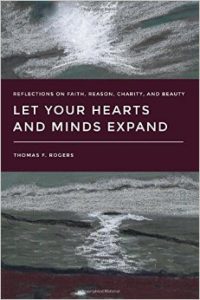 Thomas F. Rogers. Let Your Hearts and Minds Expand: Reflections on Faith, Reason, Charity, and Beauty Edited by Jonathan Langford and Linda Hunter Adams. Neal A. Maxwell Institute for Religious Scholarship.
Thomas F. Rogers. Let Your Hearts and Minds Expand: Reflections on Faith, Reason, Charity, and Beauty Edited by Jonathan Langford and Linda Hunter Adams. Neal A. Maxwell Institute for Religious Scholarship.
Thomas F. Rogers, as Terryl Givens wrote in his forward, is “one of modern Mormonism’s treasures.” This collection of essays, letters, and speeches, reflects Tom Rogers’ lifelong pursuit of those four elements named in the subtitle, Faith, Reason, Charity, and Beauty, with particular emphasis on how they affect our relationships to each other. Editing Rogers’ prodigious output down to a single volume presented a unique challenge. Jonathan Langford, a former student of Rogers, and Linda Hunter Adams, a colleague of Rogers, have accomplished that task with grace. But it is also challenging to read this collection. It is not because it isn’t clear and concise, because it is. However, you can’t read these works and not be challenged to change the way you think and act. This volume truly represents Rogers’ wide ranging thoughts and concerns, and provides a long look into his faith and commitment. Tragically, both Langford and Adams have passed away since completing this project. With this award we recognize their work and collaboration with Thomas Rogers in this truly exceptional volume.
Short Fiction
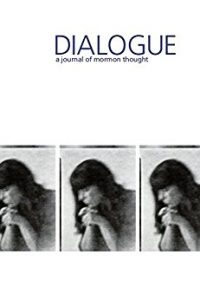 Levi S. Peterson. “Kid Kirby” Dialogue: A Journal of Mormon Thought, 49:2, Summer 2016.
Levi S. Peterson. “Kid Kirby” Dialogue: A Journal of Mormon Thought, 49:2, Summer 2016.
When asked what the purpose of literature is, the short story writer Issac Bashevis Singer responded succinctly that literature is to entertain and instruct. There’s no end to good short stories that meet one of these criterion, but a story that both entertains and instructs, a rarer specimen in the literary world, might be called a great story. Levi Peterson’s poignant and captivating “Kid Kirby” is unequivocally a great story. On the one hand, “Kid Kirby” feels well rooted in the western genre with its hardscrabble living and solitary country, the buckaroos and the brothels and the pistol-wielding, mustachioed villain, all set in the horse-drawn, violent world of the turn-of-the-century Old West. In a way, this is an origin story, detailing, filling in, and clarifying the legend of the young fast-draw artist, Reeves Kirby, who avenges the assassination of his grandfather. On the other hand, in humanizing Reeves’s origin story, laying bare for the reader his carnal struggles and youthful foibles, Peterson’s “Kid Kirby” transcends genre, rightly asserting itself as a piece of literary art. Reeves, an eighteen-year-old greenhorn with a mild temperament and a downy upper lip, lands his first real job, breaking horses for a rancher near Evanston, Wyoming. While he has the rare and sought-after talent for breaking horses, just like his hard-living grandfather, Reeves has a difficult time living within the boundaries of his Mormon faith and taming his curiosity for the vices to be found in a rough railroad town like Evanston, vices he eventually indulges and which set in motion a life-and-death struggle with the town brute, Tom Galt. “Kid Kirby” is a plot-driven, suspenseful read, entertaining in every sense of the word. But it’s also a story about spiritual refinement, divine grace, and, ultimately, doing the right thing. “Kid Kirby,” I believe, will be a classic of Mormon literature, one that future generations will enjoy.
Other finalists:
Emily Belanger, “And Thorns Will Grow There” Sunstone #180, Spring 2016.
Spencer Hyde, “Light as Wings” Glimmer Train. Fall 2016, #97.
Heidi Naylor, “The Mandelbrot Set” Sunstone Magazine, #182, Fall 2016.
Steven L. Peck. “Incomplete Slaughter” The Colored Lens, Summer 2016.
Brad R. Torgersen. “Purytans” Analog: Science Fact and Fiction, July/Aug 2016. Novella.
Short Fiction Collection
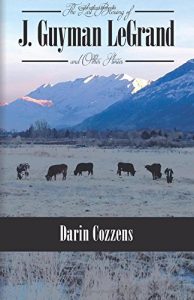 Darin Cozzens. The Last Blessing of J. Guyman LeGrand and Other Stories. Zarahemla Books.
Darin Cozzens. The Last Blessing of J. Guyman LeGrand and Other Stories. Zarahemla Books.
People speak casually of writers “capturing” places and people, but it’s hard to imagine a more felicitous way of describing what Darin Cozzens does for rural Mormon life in the high Western desert with The Last Blessing of J. Guyman LeGrand and Other Stories. The stories stand alone, and yet feel so completely complimentary, it’s hard to imagine them not existing together. This book will glide into your consciousness like a quiet melody that builds steadily into an elaborate symphony of characters and themes. By the end, you will have experienced what Tim O’Brien claims is fiction’s great superpower: “to make things present.” Here present are characters who are Mormon, sure, but who never feel anything less than utterly human. Cozzens’ work shrugs off our pre-occupations with genre and topic (“What is Mormon literature?”), and simply speaks to us that bewitching and time-honored mode: storytelling. These narratives form, as John Gardner says in The Art of Fiction, “a vivid and continuous dream.” Cozzens’ brand of realism doesn’t feel dated or quaint, but a fulfillment of the best parts of that literary tradition.
Other finalists:
Eric Freeze. Invisible Men. Outpost19.
Various authors. Windows into Hell. Curiosity Quills Press. Edited by James Wymore.
Video Series
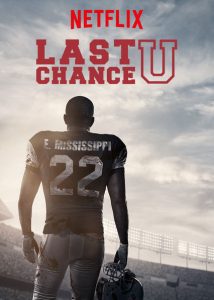 Last Chance U. Greg Whiteley, director. Netflix Original. Six episodes.
Last Chance U. Greg Whiteley, director. Netflix Original. Six episodes.
Greg Whiteley’s Last Chance U, a six-part documentary series available exclusively on Netflix, further develops the best elements of his previous work. Whiteley—like Steve James and Albert and David Maysles—excels at using the tools of observational cinema to create personal portraits, in-depth looks into the psychological and emotional lives of his subjects, whether high school students, washed up musicians, or presidential candidates. He also excels—like Frederick Wiseman and Alex Gibney—at infiltrating and analyzing complex social institutions like the Republican party in Mitt and the public school system in both Resolved and Most Likely to Succeed. Last Chance Ucontinues this latter theme by examining the football program at East Mississippi Community College, a small rural school serving underprivileged and mostly African-American students. The football program under head coach Buddy Stephens has become a national leader among junior colleges, and Whiteley covers the training and the games in detail, but as with the best sports documentaries the emphasis lies not with the game but with the players and their struggles off the field. Thus the true star of the series is Brittany Wagner, an academic advisor who takes these scholastically listless young men under her wing and gives them not just confidence and academic direction but a friend and a surrogate parent to nurture them into adulthood. A white single mother who stands feet smaller than the players who surround her, she provides the moral compass—and tough love—that they each need. Last Chance U will inevitably be compared with Hoop Dreams, but if it doesn’t provide the longitudinal perspective of that film it does give a snapshot into a transformative moment in these young men’s lives, and as such it stands as a tribute to Wagner and all the educators and coaches who have dedicated their lives to helping these young men. And in creating his first series rather than a stand-alone feature film Whiteley utilizes the six-hour running time to create a deeper and broader portrait than he has ever achieved before, marking a new phase in his already accomplished career.
Other finalists:
Adam & Eve. Davey & Bianca Morrison Dillard, directors.
Studio C. Jared Shores and Matt Meese, co-creators.
The Talking Fly. Steve Olpin, director.
Young Adult Novel
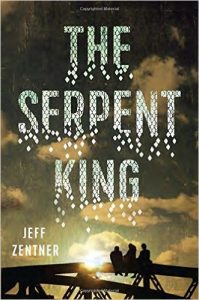 Jeff Zentner. The Serpent King. Crown Books
Jeff Zentner. The Serpent King. Crown Books
Jeff Zentner’s debut novel, The Serpent King, tells the stories of three misfits: Dill, the son of a snake-handling preacher incarcerated for possession of child pornography, Travis, whose geeky love for a popular fantasy series provides escape from an abusive father; and Lydia, a teenage fashion blogger eager to escape their small town in Tennessee for the cosmopolitan sophistication of college in New York City. Presented in alternating chapters told in third person, Zentner thoughtfully touches on themes common to young adult literature: establishing identities, drawing confidence from inner sources, staking one’s independence, and dealing with the ruptures that come from crossing into adulthood. The book also treads on less familiar ground, exploring questions of faith as seen through Dill’s doubts about his place in his family’s religious tradition; challenging stereotypic constructions of the nature of rural Southern life in these three different yet connected lives; and shedding light on issues of social class as seen in the perspectives of Lydia, the college-bound child of upper-middle class parents, and Dill and Travis, whose impoverished circumstances seem to sentence them to living out their days in their obscure, small town. The story of these richly drawn characters is emotionally vivid and immediately relatable to teen readers, and is one that will keep them thinking long after they’ve closed the cover.
Other finalists:
Julie Berry. The Passion of Dolssa. Viking
Kiersten White. And I Darken. Delacorte Press

To celebrate the AML Short Fiction award winning story “Kid Kirby”, by Levi Peterson, Dialogue is making it available for all to read. It was previously available only to subscribers. See it here:
http://www.dialoguejournal.com/wp-content/uploads/sbi/articles/Dialogue_V49N02_kidkirby.pdf
This is Levi’s 5th AML Award. He has also been awarded the Smith-Pettis Award for Outstanding Contribution to Mormon Letters, and an AML Lifetime Membership. Levi served as AML president twice, in 1980-1982 and 1989-1990, as well as serving for several years as secretary.